03Feb 2022
Can going paperless save your office money?
This question haunts professionals every quarter or fiscal year. As more businesses move to an increasingly more sustainable workforce, not only are budgets called into question, but so are the true impact business decisions have on the environment. For many, the answer has been going paperless, a recent phenomenon that sees businesses drastically limiting or eliminating their paper spend.
Paperless businesses and offices aren’t a new trend by any means. Analysts were predicting the “paperless office” as early as 1990 due to the advent and popularization of the personal computer, or PC. In an ideal world, businesses would use less paper for the good of our environment and see long-term financial benefits, but has that been the case?
DOCUdavit provides compliant and secure document management services, helping businesses digitize and manage records on their way to a true paperless office. We are acutely aware of how our services play into the running of a paper-free office and conducted a survey to better explore how businesses are saving money and creating more sustainable workplaces.
We interviewed CEOs, executives, and employees who worked in paper-free, paper-light, or remote offices. Here are our findings.
The Real Numbers: How Much Can You Save on Paper?
The highlight of our study was finding out just how much a business can save on paper by going paperless or remote. When we asked “Approximately how much in USD was your in-office paper spend before going paperless?”, this is what respondents had to say:

The average paper spend for an office rounded off at $31,000USD/year to $50,000USD/year. An astonishing 50% of respondents selected this answer. After that, 16.7% of respondents indicated that their paper spend was $51,000USD/year to $80,000USD/year, showing that paper budgets tended to start in the mid-range before steadily increasing rather than starting in the mid-range and steadily declining.
In a midsize to large company, it’s estimated that an employee prints out an average of 10,000 sheets of paper a year, according to research done through Uniprint. This means that a single employee can use between $50-$200 per year on printing, which makes our study numbers all the more intriguing.
While there is no indication of the exact size of the businesses surveyed, we can establish that a large chunk of yearly funds are spent on paper in a paper-first company. Going paperless can not only save a company money on paper, but it can also save on attributed costs, such as filing, storage, faxing, and printing.
Newer Businesses Have a Higher Paperless Rate
Based on the survey results, the paperless office as we know it doesn’t appear to be a grandfathered process.
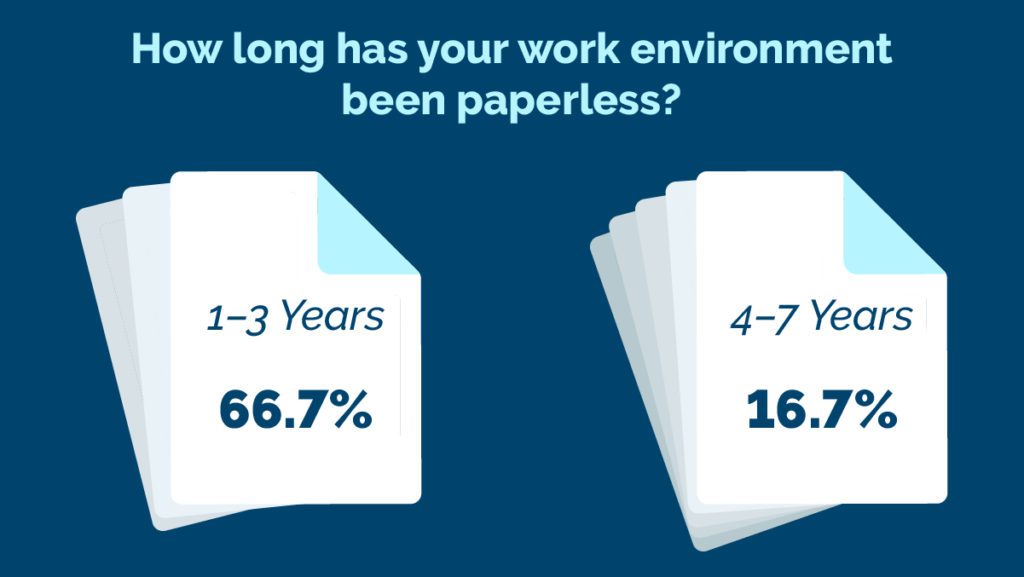
Many workplaces reported being paperless for a short time. A record 66.7% of respondents indicated that they’ve been paperless for 1-3 years. A smaller percentage of participants (16.7%) have been paperless for 4-7 years. What this tells us is that going paperless is a recent phenomenon, and it’s a phenomenon that gives newer businesses a digital advantage.
PDF Pro helps businesses digitize and edit PDFs, so they’re no stranger to understanding why some companies are less willing to take the paper-free plunge. “Many established businesses don’t invest in the continuing digital education of their employees,” says Sophie Knowles, founder and CEO. “This can lead to a cemented reliance on old practices, such physical signatures as opposed to e-signatures or physical (paper) document storage as opposed to electronic cloud storage. A simple annual review of operations to see if there are any opportunities for digital conversion, as well as investing in proper education to update those practices is ideal. It’s also a surefire way to make sure that businesses keep up with up-and-coming competitors who take advantage of the speed and optimization of digitization.”
“My Office is Paperless, but My Company Isn’t”
Going paperless has many challenges, but the biggest of all may be trying to get others on board with your mission.
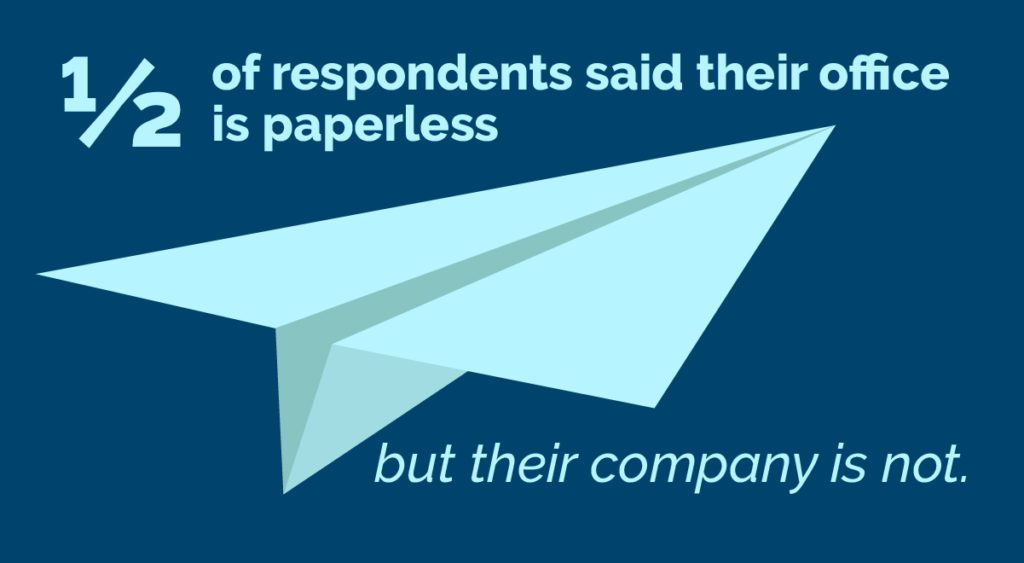
When asked “Which is true of your work environment?”, an astounding 50% of respondents said their office is paperless, but their company is not. These results tell us that, in some cases, entire companies may operate individually when it comes to ethical concerns or sustainability. This is why it’s important to note that even though a company may not be entirely paperless, their individual or satellite offices may take on a paper-free mandate and adapt accordingly.
However, having just one paperless office amidst a company that isn’t paper-free has its own ups and downs. The ability to reach out and do business with small or midsize businesses who have a sustainability mission is huge. According to our study, an anonymous responder said that being a paperless office in a sea of paper-first companies has helped their bottom line. They write: “Sometimes when a business finds out we’re paperless and we have this mandate, they’re more keen to work with us too […]”. As sustainability is growing in global business importance, being a paperless office as part of a company that hasn’t made the switch yet has its upsides.
Paperless offices are also sites of digital innovation. At DOCUdavit, we work with doctors, lawyers, and government officials who usually have free reign on processes in their offices. It’s these professionals who are at the forefront of adapting digital methods because there are decreased office politics and a greater need for day-to-day efficiency. Maybe there’s something to having a paper-free office in a paper-first company after all.
Paper-Free or Paper-Light? Can Going Remote Save Resources?
Remote businesses are often seen as a new age business model, when in reality, many businesses who are paper-free aren’t remote at all.
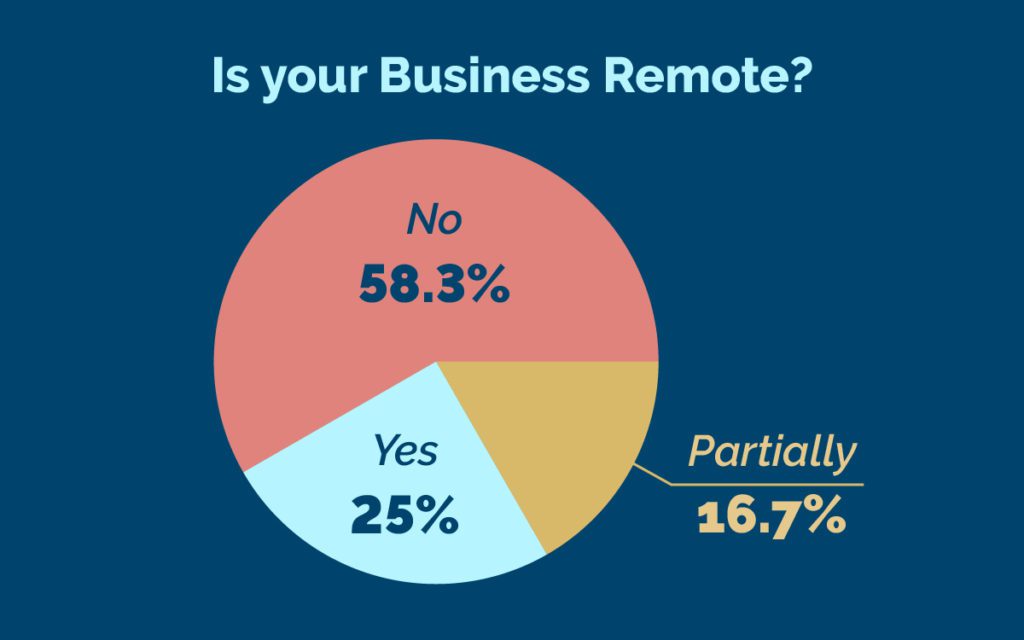
When asked if their business is remote, a whopping 58.3% of respondents said no. This doesn’t come as a surprise based on the other statistics and it’s a bold declaration that a business doesn’t have to be remote to be paperless. However, it’s important to pay attention to the 25% of respondents who indicated they are remote and the 16.7% of respondents who are partially remote. They make up 41.7% of voters and that counts for a lot.
Remote businesses have changed. Current technology has made it easier for us to communicate and do business with one another, and in today’s digital climate, it is possible to be 100% remote all the time. SEO agency CanIRank has been a remote company since its inception, and its model really lends itself to the type of work they do. “We work in SEO, so our domain is digital,” says Louisa Atto, SEO consultant. “While SEO is a long-term game, it’s much easier to keep track of processes digitally than it would be in a paper-heavy office. We collaborate better and save a lot of time and paper going back and forth by using project boards like Asana and productivity platforms like Slack.”
Allison Albert, founder and CEO of Pet Krewe, transitioned from paper to 100% electronically stored data in Q4 2019, and is seeing real financial benefits. “We probably have saved close to 15% on office supplies since we no longer have to buy ink monthly nor paper. We utilize G Suite, dropbox, bill.com and Gusto to ensure we aren’t even cutting checks anymore. It’s great and saves on office space.”
Going remote can definitely save on resources, whether it’s cutting overt costs or slashing subtle fees. When printer ink runs out, it’s normal to place another order or two, but those costs aren’t just monetary — in many cases, 50 to 70 percent of office space is used for storage, which means purchasing and maintaining filing cabinets and office supplies.
Larger benefits to going remote include faster processing and creating an eco-friendly and sustainable workflow.
The Struggles and Upsides of Being Paper-Free
While numbers don’t lie and it’s important to understand just what working in a paper-heavy office can do to your bottom line, perhaps the most interesting part of this study was getting to find out the behaviours associated with being paperless. Like any transition or process, working in a paperless office has its struggles, but it also has its upsides. When asked “what is the biggest struggle of being in a paperless work environment?”, participants were asked to select all that applied. These are the results:
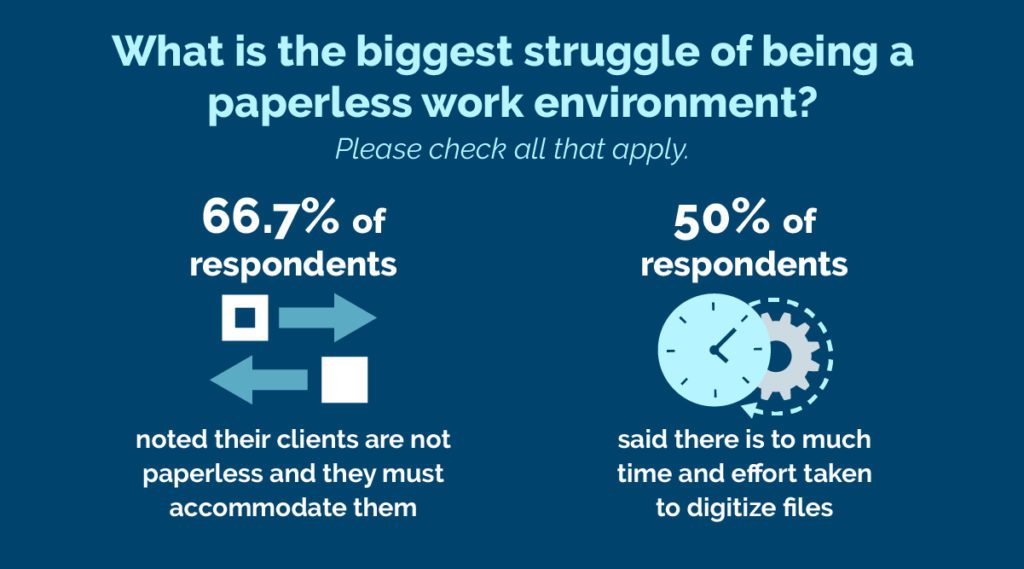
By far, the biggest struggle at 66.7% of respondents was noted as “My clients are not paperless and I must accommodate them”. Both B2B and B2C businesses cannot work in isolation. Understanding client needs is a huge part of what makes a business successful, and accommodating correspondence, whether paper or electronic, is no exception.
Fifty percent of respondents indicated that their biggest struggle is: “There is too much time and effort taken to digitize files”. While digitization does have its own timeline, a good document management system can save overhead and manage time in the long run, regardless of industry.
Richelle Delia, PhD, co-founder of Housing Joint Venture, works in a digital-only space and has seen the benefits of electronic correspondence. “Our office is 95% paperless. We bill all our customers/residents electronically, only accept electronic payments, communications are handled through our online portal and bills are paid electronically as well. When we do make manual purchases, the receipts are scanned and the transaction details are logged into our accounting system.. As a real estate based firm, we even conduct our resident screenings and leasings with digital solutions.”
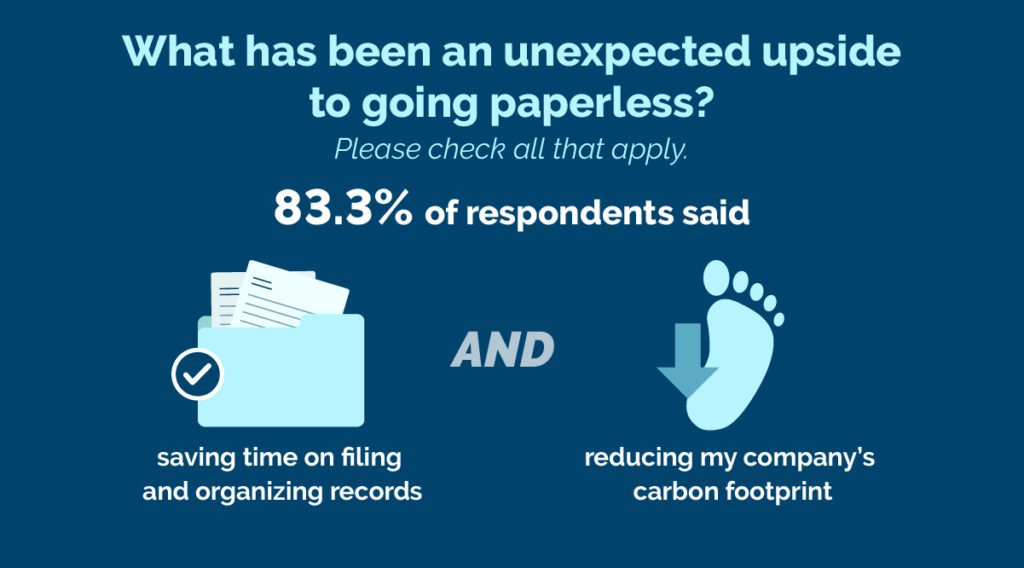
Similarly, when we asked participants to check all that applied about the unexpected benefits to going paperless, 83.3% of respondents said it was “Saving time on filing and organizing records” and “Reducing my company’s carbon footprint”.
Sustainability plays a large role in how modern businesses choose to conduct business. Liz Brown, founder of Sleeping Lucid, can’t deny the impact her company’s methods have made on the environment: “Our business largely relies on cloud-based applications and document management services when assigning tasks, collaborating on blog content, and business product documentation. These paperless processes have not only made it easier for us to go down the ‘green’ route, but it has also definitely taken a huge load off our system’s storage, and have made us more productive.”
Study Limitations
Our survey was advertised primarily to employees who worked in Canada and the United States. While we may have received responses from participants who lived in other territories, we acknowledge that our data is heavily skewed towards a North American perspective.
Similarly, our reach, while comprehensive, cannot feasibly extend to every CEO, executive, or employee who works in a paperless or remote environment. Because of this, our results show a snapshot of popular trends, but further research or a larger sample size may provide slightly different results.
Conclusion
Going paperless has its own challenges, but as we’ve discovered in our study, its short- and long-term benefits outweigh the initial transition discomfort. Going paper-free can save your business money, cut down processing times, and reduce your carbon footprint.
Many businesses we surveyed did not have a plan for going paperless prior to trying it out. 58.3% of respondents took a leap of faith for the greater good and their company’s bottom line. By using online apps like Google Drive, Evernote, and Zoom, businesses were able to create an online workflow that made sense for them and their clients in an environmentally conscious manner.
Ultimately, going paperless is a business choice that should be carefully considered with employees in mind. However, turning this business choice into a personal one for the sake of increased efficiency and a better work-life balance isn’t a bad idea either.


2 thoughts on “Eco-friendly and Budget-friendly: Can A Paperless Office Save You Money?”
Comments are closed.